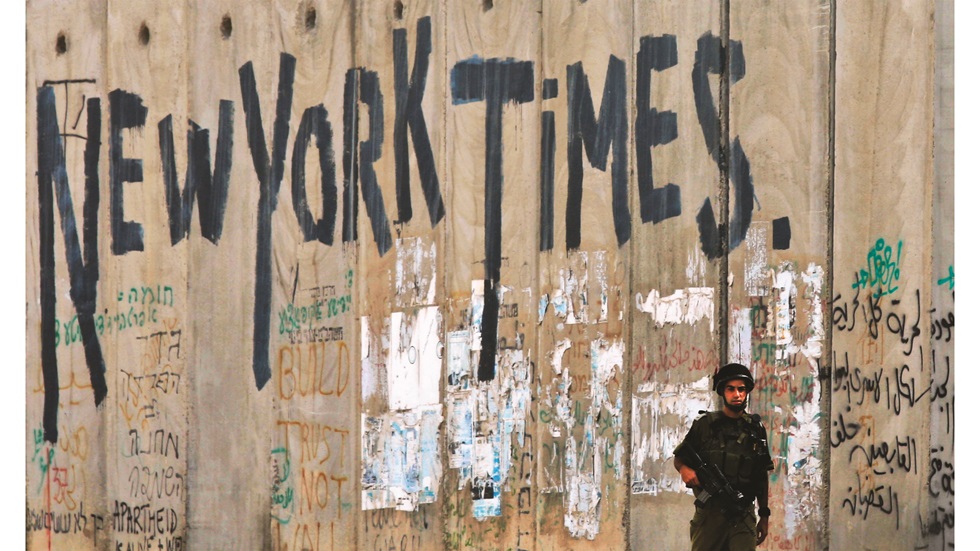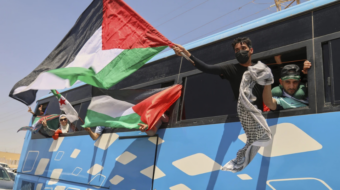
The New York Times’ coverage of the Israeli carnage in Gaza, like that of other mainstream U.S. media, is a disgrace to journalism.
This assertion should not surprise anyone. U.S. media is driven neither by facts nor morality, but by agendas, calculating and power-hungry. The humanity of 120,000 dead and wounded Palestinians because of the Israeli genocide in Gaza is simply not part of that agenda.
In a report based on a leaked The New York Times internal memo, The Intercept found out that the so-called U.S. “newspaper of record” has been feeding its journalists with frequently updated “guidelines” on what words to use, or not use, when describing the horrific Israeli mass slaughter in the Gaza Strip, starting on Oct. 7.
In fact, most of the words used in the paragraph above would not be fit to print in the Times, according to its “guidelines.”
Shockingly, internationally-recognized terms and phrases such as “genocide,” “occupied territory,” “ethnic cleansing,” and even “refugee camps,” were on the newspaper’s rejection list.
It gets even more cruel. “Words like ‘slaughter,’ ‘massacre,’ and ‘carnage’ often convey more emotion than information. Think hard before using them in our own voice,” the memo warns, leaked and verified by The Intercept and other independent media.
Though such language control is, according to the Times, aimed at fairness for “all sides,” their application was almost entirely one-sided. For example, a previous Intercept report showed that the American newspaper had, between Oct. 7 and Nov. 14, mentioned the word “massacre” 53 times when it referred to Israelis being killed by Palestinians and only once in reference to Palestinians being killed by Israel.
By that date, thousands of Palestinians had perished, the vast majority of whom were women and children, and most of them were killed inside their own homes, in hospitals, schools, or United Nations shelters. Though the Palestinian death toll was often questioned by the U.S. government and media, it was later generally accepted as accurate, but with a caveat: attributing the source of the Palestinian number to the “Hamas-run Ministry of Health in Gaza.” That phrasing is, of course, enough to undermine the accuracy of the statistics compiled by healthcare professionals, who had the misfortune of producing such tallies many times in the past.
The Israeli numbers were rarely questioned, if ever, although Israel’s own media later revealed that many Israelis who were supposedly killed by Hamas died in “friendly fire”—at the hands of the Israeli army.
And even though a large percentage of Israelis killed during the Al-Aqsa Flood Operation on Oct. 7 were active, off-duty, or reserve military, terms such as “massacre” and “slaughter” were still used in abundance. Little mention was made of the fact that many of those “slaughtered” by Hamas were, in fact, directly involved in the Israeli siege and previous massacres in Gaza.
Speaking of “slaughter,” the term, according to The Intercept, was used to describe those allegedly killed by Palestinian fighters vs. those killed by Israel at a ratio of 22 to 1.
I write “allegedly,” as the Israeli military and government, unlike the Palestinian Ministry of Health, have yet to allow for independent verification of the numbers they produced, altered, and reproduced, once again.
The Palestinian figures are now accepted even by the U.S. government. When asked, on Feb. 29, about how many women and children had been killed in Gaza, U.S. Defense Secretary Lloyd Austin said: “It’s over 25,000,” going even beyond the number provided by the Palestinian Health Ministry at the time.
However, even if the Israeli numbers are to be examined and fully substantiated by truly independent sources, the coverage by The New York Times of the Gaza war continues to point to the non-existing credibility of mainstream American media, regardless of its agendas and ideologies. This generalization can be justified on the basis that the Times is, oddly enough, still relatively fairer than others.
According to this double standard, occupied, oppressed, and routinely slaughtered Palestinians are depicted with the language fit for Israel; while a racist, apartheid, and murderous entity like Israel is treated as a victim and, despite the Gaza genocide, is somehow still in a state of “self-defense.”
The New York Times shamelessly and constantly blows its own horn of being an oasis of credibility, balance, accuracy, objectivity, and professionalism. Yet, for them, occupied Palestinians are still the villain: the party doing the vast majority of the slaughtering and the massacring.
The same slanted logic applies to the U.S. government, whose daily political discourse on democracy, human rights, fairness, and peace continues to intersect with its brazen support of the murder of Palestinians, through dumb bombs, bunker busters, and billions of dollars’ worth of other weapons and munitions.
The Intercept reporting on this issue matters greatly. Aside from the leaked memos, the dishonesty of language used by The New York Times—compassionate toward Israel and indifferent to Palestinian suffering—leaves no doubts that the Times, like other U.S. mainstream media, continues to stand firmly on Tel Aviv’s side.
As Gaza continues to resist the injustice of the Israeli military occupation and war, the rest of us, concerned about truth, accuracy in reporting and justice for all, should also challenge this model of poor, biased journalism.
We do so when we create our own professional, alternative sources of information, where we use proper language, which expresses the painful reality in war-torn Gaza.
Indeed, what is taking place in Gaza is genocide, a horrific slaughter and daily massacres against innocent, mostly unarmed peoples, whose only crime is that they are resisting a violent military occupation and a vile apartheid regime.
And if it happens that these indisputable facts generate an “emotional” response, then it is a good thing: Maybe real action to end the Israeli carnage of Palestinians would follow. The question remains: Why would The New York Times editors find this objectionable?
As with all op-eds published by People’s World, this article reflects the views of its author.
We hope you appreciated this article. At People’s World, we believe news and information should be free and accessible to all, but we need your help. Our journalism is free of corporate influence and paywalls because we are totally reader-supported. Only you, our readers and supporters, make this possible. If you enjoy reading People’s World and the stories we bring you, please support our work by donating or becoming a monthly sustainer today. Thank you!










